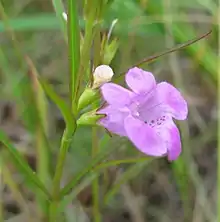Agalinis paupercula
Agalinis paupercula, commonly known as the smallflower false foxglove, is a hemiparasitic annual plant native to the eastern parts of the United States and Canada. Found in open, moist areas, its purple flowers are borne on a 30-to-70-centimeter (12 to 28 in) stem, and bloom in August and September. The species has often been treated as a variety of Agalinis purpurea, the purple false foxglove, and preliminary genetic evidence suggests that the two are, in fact, a single species.
| Agalinis paupercula | |
|---|---|
 | |
| Purple bloom | |
| Scientific classification | |
| Kingdom: | Plantae |
| Clade: | Tracheophytes |
| Clade: | Angiosperms |
| Clade: | Eudicots |
| Clade: | Asterids |
| Order: | Lamiales |
| Family: | Orobanchaceae |
| Genus: | Agalinis |
| Species: | A. paupercula |
| Binomial name | |
| Agalinis paupercula | |
| Synonyms | |
Description
Individuals of this species are herbaceous, erect annuals,[1] 30 to 70 centimeters (12 to 28 in) tall. The smooth stem[2] is four-angled[3] and may be simple or branching.[4] The stem or stems bear opposite, sessile leaves, lacking lobes, which are linear and 2 to 4 millimeters (0.08 to 0.16 in) wide.[2] Leaves on branches may be borne alternately.[4]
The flowers appear from August to September. They are borne in racemes, on pedicels of 1 to 4 millimeters (0.04 to 0.16 in),[2] borne in the leaf axils of the upper leaves. They are surrounded by a calyx of five sepals, fused into a tube at the base and separated into distinct lobes above. The pointed, triangular lobes of the calyx are almost as long as its tube. Within the calyx lies the corolla of the flower, which is campanulate (bell-shaped) and pink to purple in color, with five slightly irregular, spreading lobes. The corolla is 1.5 to 2 centimeters (0.6 to 0.8 in) in length.[2] The tube of the corolla tends to bulge on the underside. Within the flower are four stamens and a flattened stigma, the lower pair of stamens longer than the upper. The filaments are hairy near the base. The flowers mature into globose to subglobose, loculicidal fruits.[4]
Agalinis paupercula is quite similar to A. purpurea, and may represent a variety of that species. The two can be distinguished by the smaller flowers of A. paupercula (A. purpurea has a corolla of 2 to 4 centimeters (0.8 to 1.6 in)), and by the long lobes of the calyx, which in A. purpurea are typically not more than half the length of the calyx tube.[4]
Taxonomy
The taxon was originally described by Asa Gray in 1878 as Gerardia purpurea var. paupercula, a variety of the purple false foxglove. He distinguished it from more typical specimens of G. purpurea by its smaller flowers, taller stem, and lighter color.[5] In 1894, Nathaniel Lord Britton recognized it as a separate species, G. paupercula.[6] He transferred it, with the rest of the North American Gerardia, to Agalinis, as A. paupercula, in 1913.[7] Genetic studies thus far have been unable to distinguish between A. paupercula and A. purpurea, and it is possible that the two species will be consolidated again. However, these studies did not sample a large number of A. paupercula populations and are not definitive.[8]
Distribution and habitat
Distributed throughout the northeast region of the United States and in the eastern regions of Canada, A. paupercula is classified as Threatened in the state of New York, and Endangered in the states of Pennsylvania and Ohio. It is only present on Long Island at Ronkonkoma Lake.[9]
Agalinis paupercula prefers a sunny, moist habitat. Such areas include bogs, shores, barrens, and in sandy soil.[10]
Ecology
Agalinis paupercula is a hemiparasite,[4] deriving some of its nutrients from the roots of woody and herbaceous plants around it.[2] It is self-compatible when mating.[11]
References
- Britton, Nathaniel (1913). An illustrated flora of the northern United States, Canada and the British possessions. New York: C. Scribner's Sons. pp. 210. ASIN B009DLXDQA.
- Rhoads, Ann Fowler; Block, Timothy A. (2007). The Plants of Pennsylvania: An Illustrated Manual. Philadelphia: University of Pennsylvania Press. pp. 832–833.
- Black, Merel (2009). Wildflowers of Wisconsin. University of Wisconsin Press. p. 81. ISBN 0299230546.
- Gleason, Henry A.; Cronquist, Arthur (2009). Manual of Vascular Plants of Northeastern United States and Adjacent Canada. Bronx, New York: The New York Botanical Garden Press. pp. 479–480. ISBN 978-0-89327-365-1.
- Gray, Asa (1878). Synoptical flora of North America. 2 pt. 1. New York: Ivison, Blakeman, Taylor. p. 293.
- "List of Pteridophyta and Spermatophyta growing without cultivation in North America". Memoirs of the Torrey Botanical Club. 5: 295. 1894.
- Britton, Nathaniel Lord (1913). An illustrated flora of the northern United States, Canada, and the British possessions. 3. p. 210.
- Pettengill, James B; Neel, Maile C (2008). "Phylogenetic patterns and conservation among North American members of the genus Agalinis (Orobanchaceae)". BMC Evolutionary Biology. 8: 264. doi:10.1186/1471-2148-8-264. PMC 2564944. PMID 18822144.
- Taylor, Norman (1919). "A Monthly Journal of Botanical Notes and News". Torreya. XIX: 211.
- Taylor, Mary A. (May 1921). "The Figworts of Ohio". Ohio Journal of Science. XXI: 217–239.
- Neel, Maile C (2002). "Conservation implications of the reproductive ecology of Agalinis acuta (Scrophulariaceae)". American Journal of Botany. 89 (6): 972–980. doi:10.3732/ajb.89.6.972. PMID 21665696.